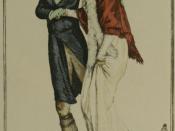Table of Contents
___________________________________________________________Page
INTRODUCTION 3
PERSONALITY TRAITS 4
ANALYSIS 6
COMMUNICATION 8
RECOMMENDATIONS 9
CONCLUSION 10
REFERENCES 11
INTRODUCTION
Diversity is a challenge that has the potential to be either a positive or a negative influence on a team. In order for diversity to have a positive effect on our Learning Team, knowledge must be combined with action. Teams that capitalize on diversity are more efficient and effective, and team diversity is a way to view a project from many different ways. There are many types of diversity that can impact the effectiveness of a group. We will discuss personality traits from the DiSC Profile Assessment of our Learning Team and relating those assessments with our lectures and reading assignments. In addition, we will provide some recommendations for the improvement of our Learning Team's behavioral styles.
PERSONALITY TRAITS
Team DiSC Style Chart
Student - Primary Style - Secondary Style
Todd Hart - (Ic) Interactive (Impresser)
Bonnie Heavener - (Ic) Interactive (Impresser)
Danielle Taylor - (Sd) Steadiness (Go-Getter)
Skip Mellinger - (Di) Dominance (Adventurer)
The chart above represents data pulled from each member of the team that took the DiSC Self Assessment test.
The DiSC test defines four styles of behavior and categorizes them as follows:
*The Dominance Style (D Style):
The Dominance Styles are forceful, take-charge people: direct, decisive, determined...and often domineering
*The Interactive Style (I Style):
The friendly, enthusiastic Interactive Styles want to be in the middle of the action, whatever and wherever it is.
*The Steadiness Style (S Style):
Easy-going and slower-paced, they believe in self-control and tend to follow the rules.
*The Cautious Style (C Style):
The Cautious Styles are results-oriented problem-solvers - but in a quiet, low-key way that's less likely to ruffle feathers.
Looking at the Primary Style category above in the Style Chart,


